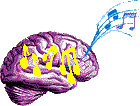Rationale
 Listening is the very first sense that develops in a young
fetus. It is also the very last sense to leave the body of a dying person.
My recent article on Music Education Beyond
the Mozart Effect explains that all music has rhythm which can be
felt and seen as well as heard. Complex elements of rhythm provide
cohesion by embodying beat, pulse, accent, meter, duration, tempo,
density, texture, form, and patterns.
Listening is the very first sense that develops in a young
fetus. It is also the very last sense to leave the body of a dying person.
My recent article on Music Education Beyond
the Mozart Effect explains that all music has rhythm which can be
felt and seen as well as heard. Complex elements of rhythm provide
cohesion by embodying beat, pulse, accent, meter, duration, tempo,
density, texture, form, and patterns.The brain is stimulated by musical qualities including rhythm, melody, harmony, timbre, style, dynamics, meaning and emotion. This unit on the sounds of water is designed to increase the long term effects of attentive listening through the engagement of musical activities. It is intended to lead students to perceive and respond to the expressiveness of music as it moves out of the realm of affect to the realm of cognition.
Objectives
- To learn how to listen attentively through words (text) and musical sounds and patterns;
- To appreciate unfamiliar melody through eurhythmics and inner listening;
- To develop depth of understanding and appreciation in integrated arts (literature and musical elements)
 Handel was born in Germany but spent most of his adult life in
England. In the late Baroque period he combined German, French, Italian
and English musical styles in his operas (40), oratorios (20), and
numerous other vocal pieces, instrumental works, and church music.
Handel was born in Germany but spent most of his adult life in
England. In the late Baroque period he combined German, French, Italian
and English musical styles in his operas (40), oratorios (20), and
numerous other vocal pieces, instrumental works, and church music.





![[email]](./gif/menue.gif)

